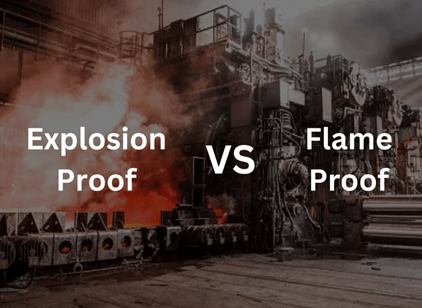Creating security in industrial environments is one of the first and most important tasks. In these environments, he used Explosion Proof Equipment to prevent fire and explosion. Sometimes the terms explosion proof and flame proof are confused. Even though these terms are sometimes used synonymously, there are clear differences between them when it comes to testing, certification, and standards. Next, we will discuss the difference between flame-proof and explosion-proof equipment.
What is the difference between flameproof and explosionproof?
flame retardant
The term flame retardant is commonly used in Europe. It usually covers hazloc items that have been approved by IEC guidelines for international use based on the zone system or approved by US certification agencies for use in the US or Canada. These flame retardant equipment always tend to be certified with the regional system.
IEC 60079-1 is a standard that focuses on the technical requirements for marking ex db with flame retardancy for IEC certification. UL 60079-1 is another standard that, however, focuses on products that require region-based certification and is specifically for US use. CSA C22.2 No. 60079-1 is similar to the previous one, but it is for Canada only.
Flameproof enclosures are secured with special devices so that they cannot be removed without the use of a special tool or, in some cases, several special tools.
To learn about the IEC guidelines, you can read the following article:
Explosion Proof
Explosion-proof systems are designed based on the class/division system and are mostly used in the United States and Canada as a protective device.
Explosion-proof systems are controlled by CSA C22.2 No. 30 and Canadian UL 1203 in the United States. Explosion-proof markings indicate the gas group, class T and the use of the designation “XP”, which, in addition to the class and division, indicates compliance with explosion-proof methods.
Explosion proof enclosures are individually factory tested to four times the maximum pressure released in an explosion and are heavier than flameproof enclosures.
To learn about explosion-proof equipment, read the following article:
What is explosion proof equipment?
In the following, we learn more about the difference between flame proof and explosion proof.
The difference between flame proof and explosion proof
Fire-proof enclosures and explosion-proof enclosures have similarities, but in other ways they have significant differences. For example, both flame-proof and explosion-proof covers are screwed onto threaded covers or tight fittings. They are connected, on the other hand, flame-resistant containers have special devices on them that we need special tools to remove.
Explosion-proof equipment and systems are used to ensure safety and compliance with local standards in industrial and explosion-prone environments. These two names are often used interchangeably, but they have different purposes and characteristics.
Flame-proof enclosures and explosion-proof enclosures each have specific advantages and disadvantages. The selection of these devices should be according to the needs and work environment.
- According to the NEC protocol in the United States, explosion-proof systems are built to last. These systems undergo extensive testing to ensure they can withstand pressures up to four times that of a gas explosion. But flameproof systems adhere to the European IEC method, focusing on overpressure testing, which is usually limited to 1.5 times normal pressure.
- American systems for detecting explosives display the class, division, group, class T and the abbreviation “XP”. On the other hand, with designations such as EX for hazardous locations, DB for flame retardant, gas group classification (such as IIC) and temperature classes (T1 to T6), flame retardant systems in Europe adhere to the zone system.
- The way to close the protective covers is very different in these two groups. Explosion-proof systems sometimes use fittings, threaded covers, or bolts that may be installed in the ground and easily modified. But special equipment and factory drilling may be required for flameproof enclosures where changes in In-flight restrictions are required.
- The most important feature that distinguishes these systems is the increase in heat. Heat gain becomes less important in explosion-proof systems because they focus on preventing explosions through solid design. But anti-flame systems control the heat well to protect you from the internal components.
- Explosion-proof systems emphasize careful design when it comes to wiring compared to flame-proof systems, which is also different.
For more information and advice on explosion-proof equipment and flame-proof equipment, you can contact our consultants.
Persian language support Phone: +98935155608
English and Arabic language support WhatsApp: 00971568410575
English and Arabic language support telegram: +16026522982

